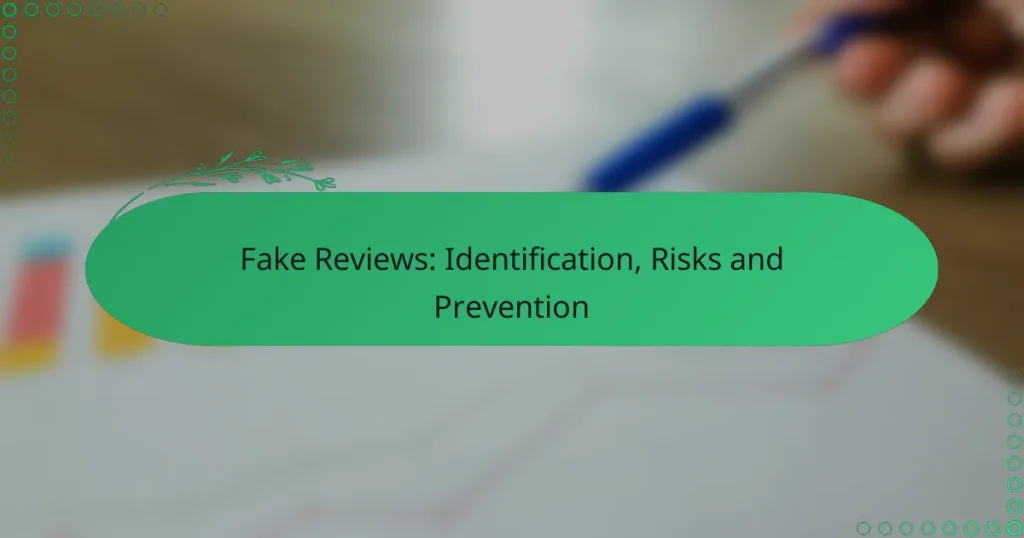Fake reviews can significantly distort consumer perceptions and business reputations, making it essential to identify and address them effectively. By examining language, review patterns, and reviewer credibility, one can discern genuine feedback from deceptive content. Implementing verification processes and fostering authentic customer interactions are vital strategies for businesses to combat this issue and maintain trust in the marketplace.
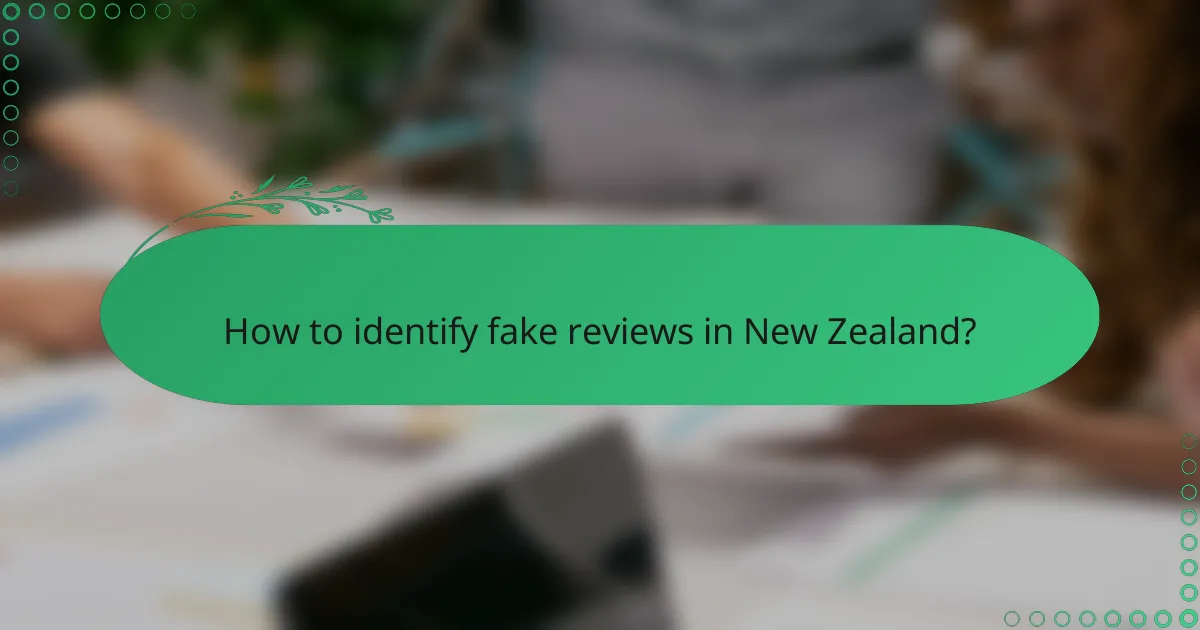
How to identify fake reviews in New Zealand?
Identifying fake reviews in New Zealand involves scrutinizing the authenticity of feedback to ensure it reflects genuine customer experiences. Key indicators include analyzing the language used, the frequency of reviews, and the credibility of the reviewer profiles.
Use review analysis tools
Review analysis tools can help detect fake reviews by analyzing patterns in language and sentiment. Many platforms utilize algorithms to flag suspicious content, making it easier to spot anomalies. Examples of such tools include Fakespot and ReviewMeta, which provide insights into review authenticity.
When using these tools, consider the overall ratings and the distribution of reviews. A sudden influx of overly positive reviews can be a red flag, suggesting manipulation. Regularly checking these tools can help maintain a trustworthy review environment.
Check for suspicious patterns
Suspicious patterns in reviews often indicate fraudulent activity. Look for reviews that are overly generic, lack specific details, or are posted in clusters within a short timeframe. For instance, if multiple reviews are submitted on the same day and use similar phrases, this could signal a coordinated effort to boost ratings.
Additionally, be cautious of accounts that only leave positive reviews for a single business or product. A diverse review history typically suggests a more credible reviewer. Monitoring these patterns can help you discern genuine feedback from deceptive content.
Verify reviewer profiles
Verifying reviewer profiles is crucial in identifying fake reviews. Check the reviewer’s history and see if they have a consistent pattern of feedback across various products or services. Profiles with limited activity or a lack of detailed reviews may indicate inauthenticity.
Look for profiles that include a profile picture, a biography, and interactions with other users. Genuine reviewers often engage with the platform and provide a variety of feedback. If a profile appears suspicious or lacks depth, consider the reviews it has posted with skepticism.
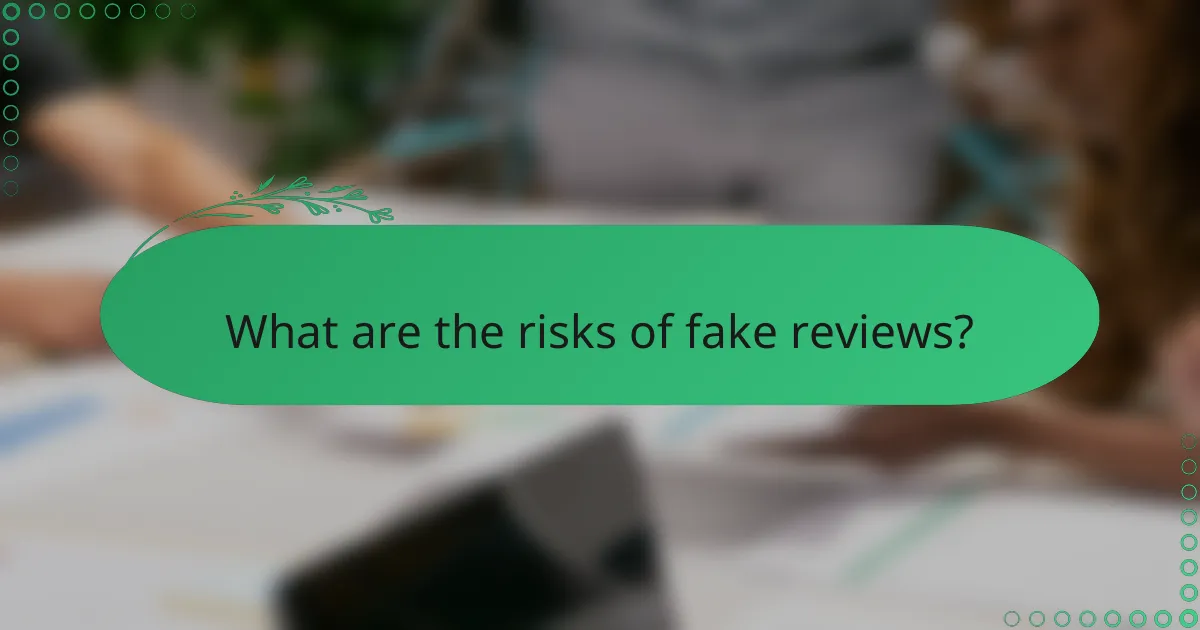
What are the risks of fake reviews?
Fake reviews pose significant risks to both consumers and businesses, undermining trust and leading to poor decision-making. Identifying and addressing these risks is crucial for maintaining a fair marketplace.
Impact on consumer trust
Fake reviews can severely damage consumer trust in brands and products. When customers discover that reviews are fabricated or misleading, they may become skeptical of genuine feedback, leading to hesitation in making purchases.
This erosion of trust can result in a negative perception of entire industries, as consumers may generalize their experiences with one brand to others. Brands that rely on authentic customer feedback must actively combat fake reviews to preserve their reputation.
Legal consequences for businesses
Businesses that engage in or fail to address fake reviews may face legal repercussions. Many countries have regulations against false advertising and deceptive marketing practices, which can result in fines or lawsuits.
In the United States, for instance, the Federal Trade Commission (FTC) enforces rules that require transparency in advertising. Companies found guilty of manipulating reviews could face significant penalties, damaging their financial standing and credibility.
Financial losses from poor decisions
Fake reviews can lead to substantial financial losses for businesses due to misguided investments and poor strategic decisions. Companies may allocate resources to products that are falsely rated highly, resulting in inventory that does not sell.
Furthermore, businesses may spend on marketing efforts based on misleading reviews, leading to wasted budgets. It is essential for companies to implement robust review verification processes to mitigate these risks and ensure informed decision-making.

How can businesses prevent fake reviews?
Businesses can prevent fake reviews by implementing robust verification processes, encouraging authentic customer feedback, and regularly monitoring reviews. These strategies help maintain credibility and trustworthiness in the eyes of potential customers.
Implement verification processes
Establishing verification processes is crucial for ensuring that reviews come from genuine customers. This can include requiring proof of purchase or using email confirmations to validate that a reviewer has actually engaged with the product or service.
Consider using third-party review platforms that offer built-in verification features. These platforms can help filter out fake reviews by confirming the identity of reviewers, thereby enhancing the overall quality of feedback.
Encourage genuine customer feedback
Encouraging genuine customer feedback involves creating an environment where customers feel comfortable sharing their experiences. This can be achieved by actively soliciting reviews through follow-up emails or during the checkout process.
Incentivizing honest feedback, such as offering discounts or loyalty points for leaving a review, can also motivate customers to share their thoughts. However, ensure that these incentives do not compromise the authenticity of the reviews.
Monitor reviews regularly
Regularly monitoring reviews allows businesses to quickly identify and address any suspicious activity. Set up alerts for new reviews and dedicate time each week to assess the feedback received.
Utilize tools that analyze review patterns and flag anomalies, such as sudden spikes in positive or negative reviews. This proactive approach helps in maintaining a trustworthy online reputation and addressing potential fake reviews promptly.
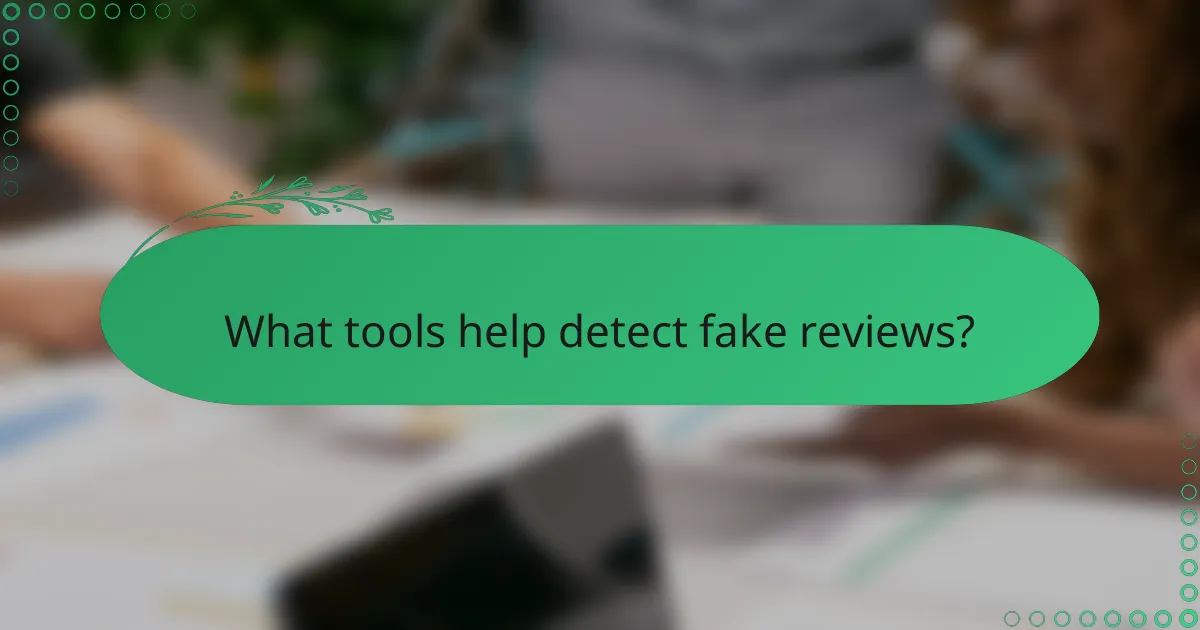
What tools help detect fake reviews?
Several tools are available to help detect fake reviews, each utilizing different methodologies to assess the authenticity of customer feedback. These tools can analyze patterns, language, and reviewer behavior to identify potentially misleading reviews.
Fakespot
Fakespot is a popular tool that evaluates the credibility of online reviews by analyzing the language used and the reviewer’s history. It assigns a letter grade to products based on the likelihood that reviews are fake, helping consumers make informed decisions. Users can simply enter a product URL, and Fakespot will provide an analysis within seconds.
While Fakespot is effective, it may not always be accurate for every product. Users should consider cross-referencing results with other tools or reading reviews directly to get a comprehensive view.
ReviewMeta
ReviewMeta focuses specifically on Amazon reviews, using algorithms to detect suspicious patterns and inconsistencies. It analyzes factors such as review timing, the reviewer’s history, and the overall rating distribution to provide an adjusted score that reflects genuine feedback. This tool is particularly useful for shoppers looking to verify the legitimacy of Amazon products.
One limitation of ReviewMeta is that it only works with Amazon listings, so users shopping on other platforms may need to use additional tools. Always consider checking multiple sources for a well-rounded perspective.
Trustpilot
Trustpilot is a review platform that allows businesses to collect and display customer feedback. It employs a verification process to ensure that reviews come from genuine customers, which helps maintain the integrity of the feedback. Users can report suspicious reviews, contributing to a community-driven effort to combat fake feedback.
While Trustpilot is effective in promoting authentic reviews, businesses can still receive negative feedback that may not reflect their service accurately. Consumers should read a range of reviews to understand the overall sentiment before making decisions based on Trustpilot ratings.
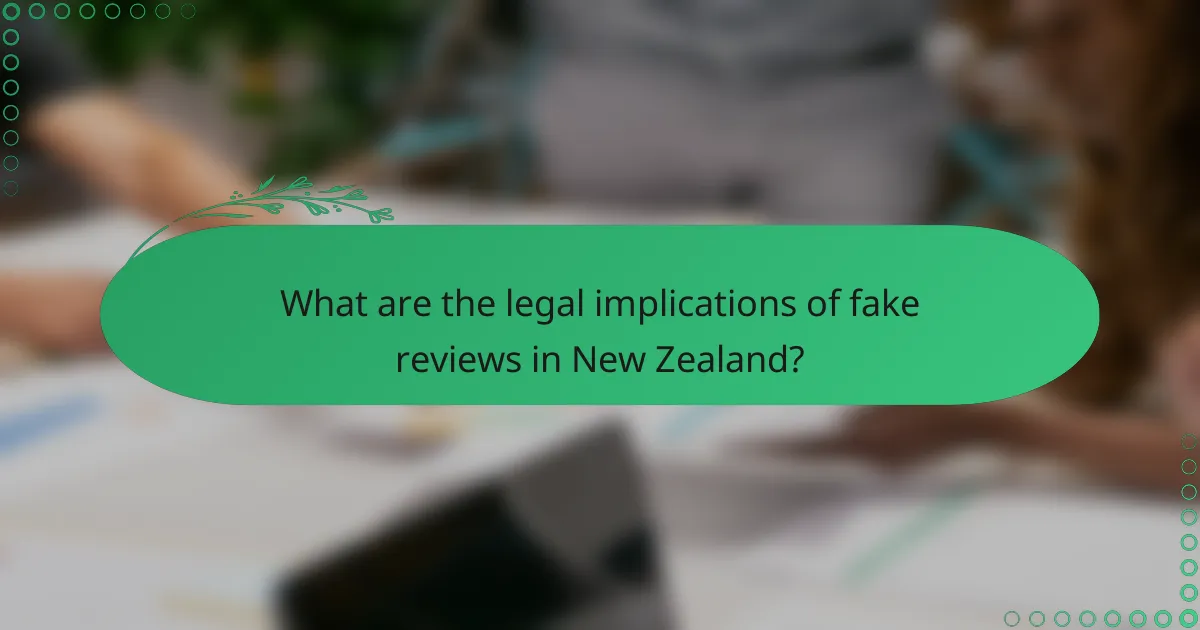
What are the legal implications of fake reviews in New Zealand?
In New Zealand, fake reviews can lead to significant legal consequences, primarily under the Fair Trading Act 1986. This legislation prohibits misleading and deceptive conduct, which includes posting false reviews that can mislead consumers.
Consumer Law violations
Posting fake reviews constitutes a violation of consumer law, as it misrepresents a product or service’s quality. Under the Fair Trading Act, businesses must ensure that any claims made about their products are truthful and not misleading. This includes reviews that are fabricated or incentivized without proper disclosure.
Consumers can report suspected violations to the Commerce Commission, which investigates and enforces compliance with consumer laws. Businesses found guilty of misleading conduct may face serious repercussions, including damage to their reputation and loss of consumer trust.
Potential fines and penalties
Violating consumer laws regarding fake reviews can result in substantial fines in New Zealand. The Commerce Commission can impose penalties that may reach up to NZD 600,000 for individuals and NZD 10 million for companies, depending on the severity of the violation.
Additionally, businesses may face civil liability, which could lead to compensation claims from affected consumers. It is crucial for businesses to maintain transparency and authenticity in their reviews to avoid these legal repercussions and protect their brand integrity.
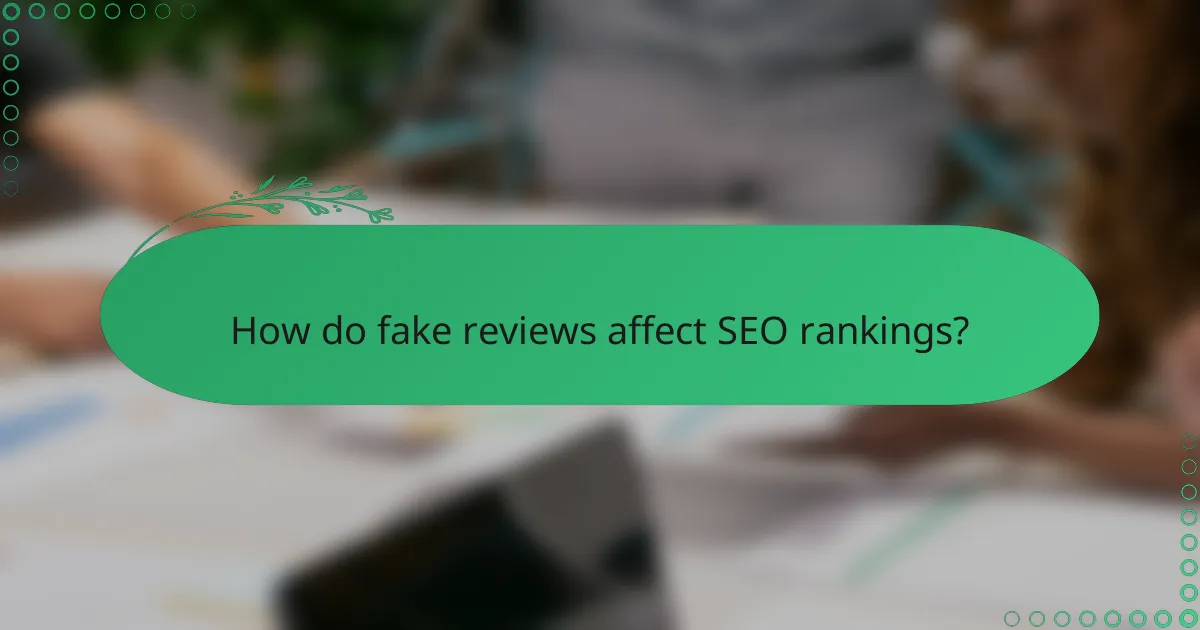
How do fake reviews affect SEO rankings?
Fake reviews can significantly harm SEO rankings by misleading search engines and users alike. Search engines prioritize authentic content, and a high volume of fake reviews can lead to penalties, reducing visibility in search results.
Negative impact on brand reputation
Fake reviews can severely damage a brand’s reputation, as consumers often rely on reviews to make purchasing decisions. If a business is associated with fraudulent reviews, it can lead to distrust and a decline in customer loyalty.
For example, a restaurant with numerous fake positive reviews may attract initial customers, but if the service does not meet expectations, negative word-of-mouth can quickly spread. This can result in a long-term decline in patronage and revenue.
To mitigate this risk, businesses should actively monitor their online reviews, respond to feedback, and encourage genuine customer reviews. Transparency and authenticity are key in maintaining a positive brand image.
